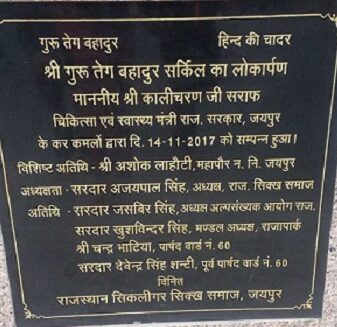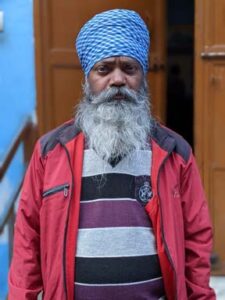In Jaipur, from Jhalana Dongri to Guru Tegh Bahadur Nagar
This is the first part of the story of the Sikligar Sikhs in this new series of Forgotten Sikhs by The World Sikh News. Here, young budding journalist and content-writer Kamaljeet Singh traces the origin of the area called Jhalana Dongri in Jaipur and how the hard-working, diligent Sikligar Sikhs strived hard to make it Guru Tegh Bahadur Nagar. WSN and Kamaljeet Singh will bring more stories about these and other hard-working Sikhs who strive to make two ends meet while observing the high ideals of the Sikh way of life.
![This is the first part of the story of the Sikligar Sikhs in this new series of Forgotten Sikhs by The World Sikh News. Here, young budding journalist and content-writer Kamaljeet Singh traces the origin of the area called Jhalana Dongri in Jaipur and how the hard-working, diligent Sikligar Sikhs strived hard to make it Guru Tegh Bahadur Nagar. WSN and Kamaljeet Singh will bring more stories about these and other hard-working Sikhs who strive to make two ends meet […]](https://www.theworldsikhnews.com/wp-content/uploads/2023/02/Jaipur-360x235.jpg)
A larger than life Khanda-the Sikh symbol stands tall in the middle of the roundabout near the Sikligar dera -the habitat, in what has come to be known as the Guru Tegh Bahadur Circle, which was built by the Sikligar Sikhs and Sikhs from Guru Nanak Pura and Raja Park, Jaipur.
You enter the area and you cannot miss the Gurdwara Guru Tegh Bahadur Nagar built by the Sikligar Sikhs through sheer hard work and their humble contributions over the decades. Around the Gurdwara live a few hundred families of iron fabricators and RCC construction workmen, whose ancestors were ace weapon-makers. The Gurdwara Guru Teg Bahadur Sahib, Jhalana Doongri Jaipur was built at the same time the elderly Sikligars moved from the areas Hathroi Kila, Shalimar to Jhalana Dongri.

I am a Sikligar Sikh living in Jhalana Dongri and this is the story of my people living in this dera and five other deras -now called colonies of Jaipur. In the city, popularly known as the Pink city, the Sikligar Sikhs live in present-day Guru Tegh Bahadur Nagar, Malviya Nagar, Galta Gate, Triveni and Shalimar Hathroi Kila.
 The story and fate of the Sikligar Sikhs in Jaipur is no different from that of Sikligars across the country -low education levels, living hand-to-mouth, yet working very hard and through honest means.
The story and fate of the Sikligar Sikhs in Jaipur is no different from that of Sikligars across the country -low education levels, living hand-to-mouth, yet working very hard and through honest means.
Prior to and after the partition of Punjab in 1947, Sikligar Sikhs of Jaipur migrated from Pakistan through land and water routes and reached various parts of India. My grandparents and many of the elderly Sikhs who are no more and whose stories are lost forever reached Jhalana Dongri in the capital city of Jaipur in the Indian state of Rajasthan. The families here are settled for more than 50 years. Brick by brick, they have pooled resources and built a Gurdwara Sahib in their midst.

Many of them prior to making Jhalana Dongri their home, lived in a fort -the Hathrai Kila, a few kilometres from this area, near the Jaipur Railway junction. Today, around 20 families still live there.
What does Jhalana Dongri mean? The word Dongri refers to a mountain. I think it is a common name in Rajasthani, Hindi and Marathi. This area was a sub-mountainous area, a vast jungle around the small mountains, water brooks everywhere and the portion of it which is still a jungle has wild life, including leopards.
 To make Jhalana Dongri liveable, the Sikligars toiled day and night. 60-year-old Sardar Desraj Singh, who has seen all these things told me “We worked very hard to fill in the place. We had to kill animals, including snakes to settle down here. Earlier on, we had to face many hardships and it was not easy to stay here.” It makes me and many Sikligar Sikh youth proud that our elders worked hard and travelled the journey from Jhalana Dongri to make it the present-day Guru Tegh Bahadur Nagar.
To make Jhalana Dongri liveable, the Sikligars toiled day and night. 60-year-old Sardar Desraj Singh, who has seen all these things told me “We worked very hard to fill in the place. We had to kill animals, including snakes to settle down here. Earlier on, we had to face many hardships and it was not easy to stay here.” It makes me and many Sikligar Sikh youth proud that our elders worked hard and travelled the journey from Jhalana Dongri to make it the present-day Guru Tegh Bahadur Nagar.
In the last many decades, I have seen the impact of modernity on Sikligar families and their breadwinners. The tall, lanky, devout Sikligar Sikhs, who were once skilled weapon makers for Guru Hargobind Sahib, Guru Gobind Singh Ji, Banda Singh Bahadur and Maharaja Ranjit Singh -making indigenous guns, Kirpans, et al, have turned to iron and steel fabricators and RCC construction workmen. In this centre of the Sikligars, some have fabrication shops and many work on construction sites in and around Jaipur.
The tall, lanky, devout Sikligar Sikhs, who were once skilled weapon makers for Guru Hargobind Sahib, Guru Gobind Singh Ji, Banda Singh Bahadur and Maharaja Ranjit Singh -making indigenous guns, Kirpans, et al, have turned to iron and steel fabricators and RCC construction workmen.

Some years ago, there were elderly people who could still make traditional Sikh weaponry like Kirpans, but today, sadly, there is no one to make them. I feel that Sikhs at large failed to patronize these talented Sikligars and that is one of the reasons that this art and craft is on the verge of extinction.

In this Dera of the Sikligars, many children have gone to schools but not many have moved beyond the tenth and twelfth standards. There is a heavy dropout of students, especially girl students. The way I look at it, I am fortunate to be guided and mentored by education activists whereas many others are not. This is one area that needs to be bolstered with regular counselling and mentoring.

 As the physical energy levels of Sikligar boys and girls is at the optimum, with many of them doing regular physical exercises and physical work, they take to sports very easily. Many enjoy playing hockey and cricket. Kuljeet Singh has been selected for Rajasthan Police through the sports quota. Randhir Singh is the first Sikligar lawyer from Jaipur, Rajasthan, practising in the district courts as well as in the High Court of Rajasthan.
As the physical energy levels of Sikligar boys and girls is at the optimum, with many of them doing regular physical exercises and physical work, they take to sports very easily. Many enjoy playing hockey and cricket. Kuljeet Singh has been selected for Rajasthan Police through the sports quota. Randhir Singh is the first Sikligar lawyer from Jaipur, Rajasthan, practising in the district courts as well as in the High Court of Rajasthan.
I have had the privilege of completing my graduation in Journalism through the positive and consistent intervention of A Little Happiness Foundation. My mother is ecstatic, “Humko to patarkar ka matlab bhi nahi pata, sanstha ne hamare ghar se yeh baat khatam kar diya ke Sikligar bachhe padhte nahi – I do not know what journalism means. The people who helped me have undone the dialogue that Sikligar children do not study.”
This organisation has enabled Jasvinder, Singh, Sukhbir Singh, Karnel Singh, Baljeet Singh and others from this centre to read and write English which has boosted their self-confidence and enabled them to get jobs.
It must be mentioned that due to the sustained intervention of social and religious activist Jasbir Singh from Raja Park, Jaipur over the last two decades, Sikligar children of Guru Tegh Bahadur Nagar are well-versed in Sikh principles and Gurmat practices. They perform Kirtan and many play Gatka. Jasbir Singh and his team ensure that school and college-going students complete their studies and this has brought about a big change in the lives of many Sikligar children. Still, much more needs to be done.
While speaking to WSN, Parmender Singh said, “I have worked as a fabricator for the last ten years. I have two children. I am 32 years old. I work hard but am still unable to save much for emergencies and exigencies.”
“I am constantly worried about the future of my children. What will they pursue after school? What is good for them and the family? It is invariably a shot in the dark and that is dreadful.”
Many young and middle-aged Sikligars, who could not get any education have also joined their parental work of fabrication and some of them are doing well while the majority live from hand to mouth. Even graduates end up as fabricators and they yearn for ways to move into other fields and endeavours.
Thinking of the life ahead of the Sikligars of Jaipur and those like them, I wish to recall the words of my mentor who says, “The Sikligar Sikhs are forgotten no more and there is hope for the future. Stay in Chardikala.”
 Kamaljeet Singh, pursuing his post-graduate studies in Journalism is a young Sikligar Sikh from Jaipur, aspiring to become a journalist, content writer and videographer.
Kamaljeet Singh, pursuing his post-graduate studies in Journalism is a young Sikligar Sikh from Jaipur, aspiring to become a journalist, content writer and videographer.

One thought on “In Jaipur, from Jhalana Dongri to Guru Tegh Bahadur Nagar”